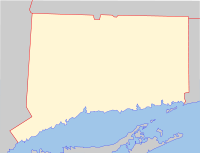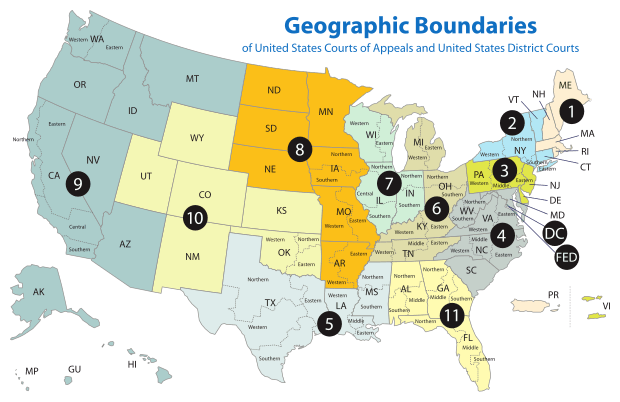United States District Court for the District of Connecticut
| United States District Court for the District of Connecticut | |
|---|---|
| (D. Conn.) | |
 | |
| Location |
Richard C. Lee U.S. Courthouse
More locations |
| Appeals to | Second Circuit |
| Established | September 24, 1789 |
| Judges | 8 |
| Chief Judge | Stefan R. Underhill |
| Officers of the court | |
| U.S. Attorney | John Durham |
|
www | |
The United States District Court for the District of Connecticut (in case citations, D. Conn.) is the Federal district court whose jurisdiction is the state of Connecticut. The court has offices in Bridgeport, Hartford, and New Haven. Appeals from the court are heard by the United States Court of Appeals for the Second Circuit. It was one of the original 13 courts established by the Judiciary Act of 1789, 1 Stat. 73, on September 24, 1789.[1] The Court initially had a single judge, and remained so composed until March 3, 1927, when a second judge was added by 1927 44 Stat. 1348.[1] Six additional judgeships were created between 1961 and 1990 to bring about the current total of eight judges.[1] Court offices at Hartford and New Haven are located in the Abraham A. Ribicoff Federal Building and the Richard C. Lee United States Courthouse.
Cases decided by the District of Connecticut are appealed to the United States Court of Appeals for the Second Circuit (except for patent claims and claims against the U.S. government under the Tucker Act, which are appealed to the Federal Circuit).
The United States Attorney's Office for the District of Connecticut represents the United States in civil and criminal litigation in the court. The current United States Attorney is John Durham.
The current United States Marshal for the District of Connecticut is Joseph P. Faughnan, the former Chief of Police for the Town of Clinton, Connecticut.
Current judges
| # | Title | Judge | Duty station | Born | Term of service | Appointed by | ||
|---|---|---|---|---|---|---|---|---|
| Active | Chief | Senior | ||||||
| 33 | Chief Judge | Stefan R. Underhill | Bridgeport | 1956 | 1999–present | 2018–present | — | Clinton |
| 32 | District Judge | Janet C. Hall | New Haven[2] | 1948 | 1997–present | 2013–2018 | — | Clinton |
| 35 | District Judge | Vanessa Lynne Bryant | Hartford | 1954 | 2007–present | — | — | G.W. Bush |
| 36 | District Judge | Michael P. Shea | Hartford | 1967 | 2012–present | — | — | Obama |
| 37 | District Judge | Jeffrey A. Meyer | New Haven | 1963 | 2014–present | — | — | Obama |
| 38 | District Judge | Victor Allen Bolden | Bridgeport | 1965 | 2014–present | — | — | Obama |
| 39 | District Judge | Kari A. Dooley | Bridgeport | 1963 | 2018–present | — | — | Trump |
| 40 | District Judge | vacant | — | — | — | — | — | — |
| 21 | Senior Judge | Ellen Bree Burns | inactive | 1923 | 1978–1992 | 1988–1992 | 1992–present | Carter |
| 22 | Senior Judge | Warren William Eginton | Bridgeport | 1924 | 1979–1992 | — | 1992–present | Carter |
| 26 | Senior Judge | Alfred V. Covello | Hartford | 1933 | 1992–2003 | 1998–2003 | 2003–present | G.H.W. Bush |
| 27 | Senior Judge | Robert N. Chatigny | Hartford | 1952 | 1994–2017 | 2003–2009 | 2017–present | Clinton |
| 28 | Senior Judge | Dominic J. Squatrito | Hartford | 1939 | 1994–2004 | — | 2004–present | Clinton |
| 29 | Senior Judge | Alvin W. Thompson | Hartford | 1953 | 1994–2018 | 2009–2013 | 2018–present | Clinton |
| 30 | Senior Judge | Janet Bond Arterton | New Haven | 1944 | 1995–2014 | — | 2014–present | Clinton |
Vacancies and pending nominations
| Seat | Seat last held by | Vacancy reason | Date of vacancy | Nominee | Date of nomination |
|---|---|---|---|---|---|
| 3 | Alvin W. Thompson | Senior Status | August 31, 2018 | – | – |
Former judges
| # | Judge | State | Born–died | Active service | Chief Judge | Senior status | Appointed by | Reason for termination |
|---|---|---|---|---|---|---|---|---|
| 1 | Richard Law | CT | 1733–1806 | 1789–1806 | — | — | Washington | death |
| 2 | Pierpont Edwards | CT | 1750–1826 | 1806–1826 | — | — | Jefferson | death |
| 3 | William Bristol | CT | 1779–1836 | 1826–1836 | — | — | J.Q. Adams | death |
| 4 | Andrew T. Judson | CT | 1784–1853 | 1836–1853 | — | — | Jackson | death |
| 5 | Charles A. Ingersoll | CT | 1798–1860 | 1853–1860 | — | — | Pierce | death |
| 6 | William Davis Shipman | CT | 1818–1898 | 1860–1873 | — | — | Buchanan | resignation |
| 7 | Nathaniel Shipman | CT | 1828–1906 | 1873–1892[3] | — | — | Grant | appointment to 2d Cir. |
| 8 | William Kneeland Townsend | CT | 1849–1907 | 1892–1902 | — | — | B. Harrison | appointment to 2d Cir. |
| 9 | James Perry Platt | CT | 1851–1913 | 1902–1913 | — | — | T. Roosevelt | death |
| 10 | Edwin Stark Thomas | CT | 1872–1952 | 1913–1939 | — | — | Wilson | resignation |
| 11 | Warren Booth Burrows | CT | 1877–1952 | 1928–1930 | — | — | Coolidge | resignation |
| 12 | Carroll C. Hincks | CT | 1889–1964 | 1931–1953 | 1948–1953 | — | Hoover | appointment to 2d Cir. |
| 13 | J. Joseph Smith | CT | 1904–1980 | 1941–1960 | 1953–1960 | — | F. Roosevelt | appointment to 2d Cir. |
| 14 | Robert P. Anderson | CT | 1906–1978 | 1954–1964 | 1960–1964 | — | Eisenhower | appointment to 2d Cir. |
| 15 | William H. Timbers | CT | 1915–1994 | 1960–1971 | 1964–1971 | — | Eisenhower | appointment to 2d Cir. |
| 16 | Mosher Joseph Blumenfeld | CT | 1904–1988 | 1961–1977 | 1971–1974 | 1977–1988 | Kennedy | death |
| 17 | T. Emmet Clarie | CT | 1913–1997 | 1961–1983 | 1974–1983 | 1983–1997 | Kennedy | death |
| 18 | Robert C. Zampano | CT | 1928–2004 | 1964–1977 | — | 1977–1994 | L. Johnson | retirement |
| 19 | Jon O. Newman | CT | 1932–present | 1971–1979 | — | — | Nixon | appointment to 2d Cir. |
| 20 | T. F. Gilroy Daly | CT | 1931–1996 | 1977–1996 | 1983–1988 | — | Carter | death |
| 23 | José A. Cabranes | CT | 1940–present | 1979–1994 | 1992–1994 | — | Carter | appointment to 2d Cir. |
| 24 | Peter Collins Dorsey | CT | 1931–2012 | 1983–1998 | 1994–1998 | 1998–2012 | Reagan | death |
| 25 | Alan Harris Nevas | CT | 1928–present | 1985–1997 | — | 1997–2009 | Reagan | retirement |
| 31 | Christopher F. Droney | CT | 1954–present | 1997–2011 | — | — | Clinton | appointment to 2d Cir. |
| 34 | Mark R. Kravitz | CT | 1950–2012 | 2003–2012 | — | — | G.W. Bush | death |
Chief judges
Chief judges have administrative responsibilities with respect to their district court. Unlike the Supreme Court, where one justice is specifically nominated to be chief, the office of chief judge rotates among the district court judges. To be chief, a judge must have been in active service on the court for at least one year, be under the age of 65, and have not previously served as chief judge. A vacancy is filled by the judge highest in seniority among the group of qualified judges. The chief judge serves for a term of seven years or until age 70, whichever occurs first. The age restrictions are waived if no members of the court would otherwise be qualified for the position.
When the office was created in 1948, the chief judge was the longest-serving judge who had not elected to retire on what has since 1958 been known as senior status or declined to serve as chief judge. After August 6, 1959, judges could not become or remain chief after turning 70 years old. The current rules have been in operation since October 1, 1982.
Succession of seats
|
|
|
|
| ||||||||||||||||||||||||||||||||||||||||||||||||||||||||||||||||||||||||||||||||||||||||||
|
|
|
|
| ||||||||||||||||||||||||||||||||||||||||||||||||||||||
List of U.S. Attorneys
- Pierpont Edwards 1789 – 1806[4]
- Hesekiah Huntington 1806 – 1829
- Nathan Smith 1829
- Asa Child 1829 – 1834
- William S. Holabird 1834 – 1841
- Charles Chapman 1841 – 1844
- Jonathan Stoddard 1844 – 1849
- Thomas C. Perkins 1849 – 1853
- Elisha S. Abernethy 1853
- William D. Shipman 1853 – 1860
- Tilton E. Doolittle 1860 – 1861
- Hiram Willey 1861 – 1870
- Calvin G. Child 1870 – 1880
- Daniel Chadwick 1880 – 1884
- Lewis E. Stanton 1884 – 1888
- George G. Sill 1888 – 1892
- George P. McLean 1892 – 1896
- Charles W. Comstock 1896 – 1900
- Francis H. Parker 1900 – 1908
- John T. Robinson 1908 – 1912
- Frederick A. Scott 1912 – 1915
- Thomas J. Spellacy 1915 – 1918
- John F. Crosby 1918 – 1919
- Edward H. Smith 1919 – 1923
- Allan K. Smith 1923 – 1924
- John Buckley 1924 – 1933
- Frank S. Bergin 1933 – 1934
- George H. Cohen 1934
- Robert P. Butler 1934 – 1945
- Adrian W. Maher 1945 – 1953
- Simon S. Cohen 1953 – 1958
- Harry W. Hultgren, Jr. 1958 – 1961
- Robert C. Zampano 1961 – 1964
- F. Owen Eagan 1964
- Jon O. Newman 1964 – 1969
- Stewart H. Jones 1969 – 1974
- Harold J. Pickerstein 1974
- Peter C. Dorsey 1974 – 1977
- Richard Blumenthal 1977 – 1981
- Alan H. Nevas 1981 – 1985
- Stanley A. Twardy, Jr 1985 – 1991
- Richard Palmer 1991
- Albert S. Dabrowski 1991 – 1993
- Christopher F. Droney 1993 – 1997
- John H. Durham 1997 – 1998
- Stephen C. Robinson 1998 – 2001
- John A. Danaher III 2001 – 2002
- Kevin J. O’Connor 2002 – 2008
- Nora R. Dannehy 2008 – 2010
- David B. Fein 2010 – 2013
- Deirdre M. Daly 2013 – 2017
- John H. Durham 2017 – Present
See also
Notes
- 1 2 3 U.S. District Courts of Connecticut, Legislative history, Federal Judicial Center.
- ↑ http://www.ctpost.com/default/article/Out-of-state-judges-coming-to-Connecticut-to-help-3887918.php
- ↑ Recess appointment; formally nominated on December 2, 1873, confirmed by the United States Senate on December 8, 1873, and received commission on December 8, 1873.
- ↑ https://www.justice.gov/usao-ct/office

